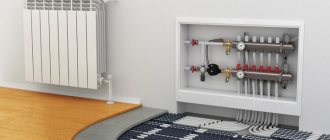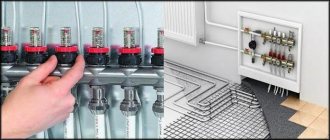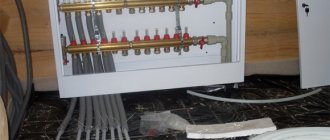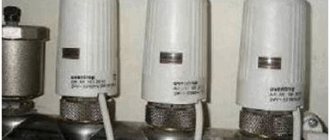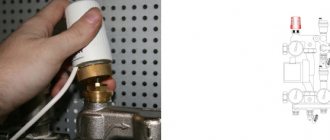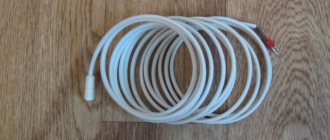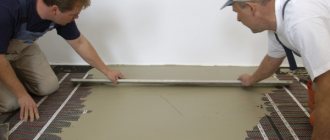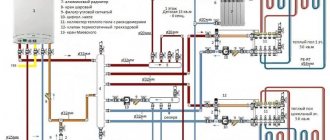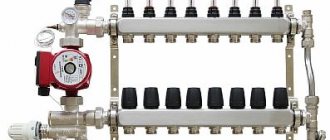Today, in order to make living conditions in the house more comfortable during the cold season, most owners install water-heated floors. But even with proper design and installation of the system, it is not always possible to achieve a comfortable microclimate in the apartment.
The reason lies in incorrect adjustment of the heating system. Therefore, it is important to understand how to properly set up a water-heated floor.
For your information! The advantage of individual heating structures is the ability to regulate the optimal thermal level at minimal costs.
Optimal temperature parameters
Setting up a water heated floor is carried out depending on individual needs. Some people like it when the room is warm, while others prefer invigorating freshness, even in the most severe frosts. But despite this, there are general standards that were developed taking into account sanitary standards, these include:
- floor heating up to 28 degrees;
- if there is another heat source or if you live indoors permanently, the ideal level is from 22 to 26 - these are optimal conditions for a person;
- if this type of heat source is the only one, or it is located in the bathroom, corridor, balcony, or in a house where people do not live permanently, it is permissible to raise the degree to 32.
Therefore, when regulating water floors, in addition to your preferences, so that the microclimate in the apartment is healthy, you should take these standards into account.
Design and principle of operation of servomotors
The main working element of the servo drive is the bellows. Those. same detail as in . A small, sealed cylinder with an elastic body is filled with a substance that is sensitive to temperature. Depending on whether the temperature increases or decreases, the volume of the substance changes accordingly. The figure - diagram clearly demonstrates the structure of the servomotor, where the bellows occupies the main place.
The bellows is in close contact with the electric heating element. Receiving a signal from the thermostat, the heating element is switched on from the mains and starts working. Inside the bellows, the substance is heated and increases in volume. Thus, the cylinder, which has increased in size, begins to put pressure on the rod, changing its position and blocking the path of coolant flow. Evaluating the operation of the servo drive, we can conclude that the device is not equipped with any motors, it does not have any gears or transmission links. The usual working connection is “thermal energy and electricity”. Hence the common name for the devices, thermoelectric regulators.
In order for the valve to become open again, the entire process is repeated only in the opposite direction. Lack of power causes the heating element to stop working. Consequently, the substance inside the cylinder cools, decreasing in volume. The pressure on the rod decreases, it rises, acting on the valve, and, consequently, hot water access to the system opens.
Having become familiar with the principle of operation of the device, it is important to remember that the mechanical action of the valve requires a certain time. Despite the fact that when a signal is received from the thermostat, the heating element begins to heat the substance inside the cylinder. The time required for changes in the physical state of the liquid is 2-3 minutes, so the valve is not activated immediately
Unlike heating, cooling of a liquid occurs more slowly. To the reverse process, i.e. Closing the valve will no longer take 2-3 minutes, but 10-15 minutes. If overheated, each servomotor should automatically turn off. For this purpose, the design provides an emergency shutdown mechanism.
For example: the servos used in the operation of the collector group are not all equipped with cylinders and cylinders with a substance. There are models in which this role is played by thermocouples, resembling a spring or plate, which heat up under the influence of the same heating element. Expanding, these parts again act on the rod, ultimately bringing the valve into working condition. You can determine what position the valve is in by changing the appearance of the servomotor. The retractable element signals the operation of the device. If this does not happen, it means that your device is not connected correctly or the heating system is not working properly.
Connection diagrams
Water-heated floors often act as an additional source of heat. It is mainly combined with a general heating system or hot water supply. The specifics of adjusting heated floors depend on the connection method.
There are several schemes for connecting water heating devices.
Combined
A popular and technologically justified method is combined heating, which includes a radiator and a heated floor system. However, to arrange this structure we will need:
- boiler;
- pump;
- expansion tank;
- collectors for radiators and heated floors;
- radiators;
- pipes.
It is important to correctly combine different heating devices so that they function effectively. The main methods of connecting radiators with warm water floors into a single structure:
- Parallel connection of the collector unit to the heating system. The circuits cut into the highway up to the batteries. Liquid circulation is provided by a pump.
- Connection via rings, primary or secondary. When laid, the pipeline forms rings; they cut into the supply system in several places. The coolant temperature depends on the distance of the coil from the heat source.
- Connection to a coplanar manifold, to its extreme point. Water moves in the circuit due to the operation of a common house pump located in the generator room. In this case, the warm floor has priority when supplying hot coolant.
- Using a hydraulic distribution unit is an excellent option: if there are several heating devices, with differences in the length of the floor loops and the water flow in them. In this scheme, you also cannot do without a coplanar collector.
- Local connection of the circuit through a unibox in a parallel circuit. Suitable for rooms with a small area: bathroom, corridor.
Connection to radiator
A common way to recharge underfloor heating is from radiators. With this scheme, the temperature of the liquid in the water floor is directly related to the degree of its heating in the radiator.
Find out the maximum and optimal coolant temperature in an underfloor heating system.
To build this system, you need a main line that has a supply and return, as well as floor pipes and a unibox. Since the water in the radiators heats up to 80 degrees, it is recommended to connect the floor loops to the return line.
Unibox - device, types and principle of operation, advantages of use, do-it-yourself installation.
From the boiler
This is a simple option - the installed boiler is intended only for heating water for heated floors, so no regulators are needed.
If you have a modern gas boiler, it is able to regulate the temperature itself; just set the required indicator on the panel. Even with a two-contact system, when the boiler heats water for radiators and heated floors, the values for each device can be easily adjusted by the boiler’s automatic system.
When using a boiler that runs on solid fuel, a compensating barrel is required. The level of temperature and pressure is regulated by installing a safety unit on the barrel, which consists of a pressure gauge, an air release valve and a thermostat.
For your information! The functioning of a water heated floor is affected by the pipe laying pattern - find out what laying patterns there are, as well as how to connect heated floors. With a “snake”, the heating will be uneven, with cold and hot areas. When the circuit is placed according to the “snail” pattern, uniform heating is ensured.
Purpose and types
A warm water floor is distinguished by a large number of pipe circuits and a low temperature of the coolant circulating in them. Basically, heating the coolant to 35-40°C is required. The only boilers that can operate in this mode are condensing gas boilers. But they are rarely installed. All other types of boilers produce hotter water at the outlet. However, it cannot be run into the circuit at this temperature - a too hot floor is uncomfortable. To reduce the temperature, mixing units are needed. In them, in certain proportions, hot water from the supply and cooled water from the return pipeline are mixed. After which, through the manifold for the heated floor, it is supplied to the circuits.
Manifold for underfloor heating with mixing unit and circulation pump
To ensure that all circuits receive water at the same temperature, it is supplied to a heated floor comb - a device with one input and a number of outputs. Such a comb collects cooled water from the circuits, from where it enters the boiler inlet (and partially goes to the mixing unit). This device - supply and return combs - is also called a manifold for heated floors. It can come with a mixing unit, or maybe just combs without any additional “load”.
Materials
The manifold for heated floors is made of three materials:
- Of stainless steel. The most durable and expensive.
- Brass. Average price category. When using high-quality alloy, they last a very long time.
- Polypropylene. The cheapest. For working with low temperatures (as in this case), polypropylene is a good budget solution.
Manifold for underfloor heating with 6 circuits
During installation, the inputs of the heated floor circuits are connected to the supply comb of the manifold, and the loop outputs are connected to the return comb. They are connected in pairs to make adjustments easier.
Equipment
When installing a water heated floor, it is recommended to make all contours the same length. This is necessary so that the heat transfer from each loop is the same. It’s just a shame that this ideal option doesn’t come around very often. Much more often there are differences in length, and significant ones.
To equalize the heat transfer of all circuits, flow meters are installed on the supply comb, and control valves are installed on the return comb. Flow meters are devices with a transparent plastic cover with printed graduations. There is a float in the plastic case, which marks the speed at which the coolant moves in a given loop.
It is clear that the less coolant passes through, the cooler the room will be. To adjust the temperature regime, the flow rate on each circuit is changed. With this configuration of the manifold for heated floors, this is done manually using control valves installed on the return comb.
The flow rate is changed by turning the knob of the corresponding regulator (they are white in the photo above). To make it easier to navigate, when installing the collector unit, it is advisable to sign all the circuits.
Flow meters (right) and servos/servos (left)
This option is not bad, but you have to regulate the flow rate, and therefore the temperature, manually. This is not always convenient. To automate the adjustment, servo drives are installed at the inputs. They work in tandem with room thermostats. Depending on the situation, a command is sent to the servo drive to close or open the flow. In this way, maintaining the set temperature is automated.
Temperature
The operating principle of a water heated floor is different from the functioning of other heating devices. The main difference is in the level of heating of the coolant. Water heated to 80 degrees is supplied to the radiators; for water floor circuits, a maximum of 42 degrees. At this temperature, the heating of the floor covering will reach 26 degrees.
There are two methods for adjusting the temperature of water heated floors:
- Carrying out control at the collector supply unit by mixing waste water. This is achieved by equipping a three-way valve with a thermostatic head. During operation, the temperature of the water, not the air, is taken into account, and a constant volume of liquid consumed is ensured, with a slight fluctuation in its temperature.
- By limiting the flow of heated coolant into the pipes. This also requires a thermal head, this is placed on the three-way valve and is used to stop the return flow. In this case, the supply and return taps are connected to the bypass, through which the flow is adjusted using a limiting valve. Since heated floors are inert, water is supplied to the pipes at a nominal temperature, and only its consumption changes.
In both methods, the thermostatic head operates based on the return temperature.
How to save money on a mixing unit
Many master plumbers consider it an integral part of the underfloor heating manifold, although these are 2 different elements that perform separate functions. The task of the comb is to distribute the coolant along the circuits, and the mixing unit is to limit its temperature to 35-45 °C, maximum 55 °C. The collector connection diagram shown below works according to the following algorithm:
- While the system is warming up, the two-way valve on the supply side is completely open and allows maximum water through.
- When the temperature rises to the calculated value (usually 45 °C), the remote sensor acts on the thermal head, and it begins to block the flow through the valve, pressing on the rod.
- After the valve mechanism is completely closed, the coolant, stimulated to move by the pump, circulates only in a closed floor heating network.
- The gradual cooling of the water is detected by a temperature sensor, causing the thermal head to release the rod, the valve opens and a portion of hot water enters the system, while some of the cold water goes back. The heating cycle repeats.
Good news for those who are very limited in funds, but want to heat themselves with warm floors: installing a two- or three-way valve with a pump is not always necessary. There are two ways to reduce the cost of the system by avoiding the purchase of a mixer:
- power the heating circuits directly from the gas boiler through the manifold;
- install RTL thermal heads on the manifold valves.
The manifold assembly, assembled from brass tees, provides for regulation by automatically limiting the reverse flow with RTL heads.
Let us immediately note that the first option contradicts all the canons and cannot be considered correct, although it is used quite successfully. The bottom line is this: high-tech wall-mounted gas boilers can maintain the temperature of the supplied water at 40-50 °C, which is acceptable for heated floors. But there are 3 negative points:
- In spring and autumn, when there is minimal frost outside, the boiler will not be able to lower the coolant temperature below 35 ° C, causing the rooms to become stuffy and hot due to heating of the entire floor surface.
- In the minimum combustion mode, the parts of the heating unit are covered with soot twice as quickly.
- Due to the same mode, the efficiency of the heat generator is reduced by 5-10%.
Thermostatic heads of the RTL type operate on the principle of a two-way valve, only they are located on each circuit and are not equipped with remote sensors. A thermoelement that responds to changes in water temperature is located inside the head and blocks the flow along the circuit when it has heated up above 45-55 ° C (depending on the adjustment). In this case, the comb is connected directly to a heat source running on any type of fuel - wood, diesel or pellets.
Important condition. For normal operation of heated floors controlled by RTL thermal heads, the length of each circuit should not exceed 60 m
More details about the design of such heating and the correct schemes for assembling the collector are described in a separate instruction and in the next video:
Rules for refueling the system
It is impossible to correctly configure the functioning of a water structure if the volume of liquid in the pipeline changes independently. This can happen if there is air in the system - see the instructions on how to bleed air from a heated floor yourself. Therefore, it is important to both professionally install the structure and fill it correctly.
To ensure high-quality filling of the system, both collector branches should be equipped with automatic air vents. Refilling of floor hinges should be carried out separately from other heating devices. The generator and radiators are filled in advance. Before refueling, the manifold inlet valves are closed.
To properly start the floor, you need to connect a hose from a water supply source or pump to the supply valve, and a hose for air outlet to the return valve.
You need to start filling the water floor from the collector and its distribution units. To do this, the flow meters of the supply valve are opened fully, at which point the return taps should be turned off.
The loops are filled one by one, water is released until it comes out of the bleed hose clean and without air bubbles. The water should be started with low pressure, this will make the process of air leaving the pipes more even. After threading all the loops, the device can be turned on.
Working with Manifold Flow Meters
Balancing a warm floor means determining the standards for each loop. After all, depending on the size of the floor branch, in order for the coolant to cool down according to the calculated value while passing through it, the amount of water required varies. The volume of liquid that the loop passes through is the thermal load on it.
It is often recommended to determine the coolant flow rate based on the power of the pump, that is, the volume of incoming liquid is divided proportionally by the length of the loops. However, you should abandon this method, since it is not easy to accurately calculate the size of each coil using this method.
In addition, calculations using this method lead to a discrepancy between the pressure in the loop and the calculated value, which makes it impossible to adjust the design.
The adjustment process with flow meters itself is simple - an article with step-by-step instructions. The throughput of the device is adjusted depending on the model, either by turning the body or the stem using a key. The device displays the amount of water in liters that has passed per minute; you just need to set the desired value.
Basically, when adjusting the capacity of one loop, a change occurs in the others. Therefore, the process should be repeated sequentially with each flowmeter. Significant failures indicate that the fittings have poor flow capacity, or the circulating pump has low performance.
How to adjust a warm water floor manually preparation and input
Manual adjustment is carried out using a conventional tap called a thermal head. It is mounted on the return and supply. Using a crane allows you to avoid loading the system with automation and additional equipment. This significantly reduces costs, but creates a number of inconveniences. High-quality and quick adjustment of a warm water floor with a thermal head is a myth. You will have to turn the tap often, and when determining the temperature, rely solely on personal sensations.
Important! It is considered more convenient to regulate water heated floors using rotameters (flow meters), which are installed at the entrance to each circuit (manifold installation location). All you need is to control the permissible difference in instrument readings. It is 0.3-0.5 l
It is 0.3-0.5 l.
Correct adjustment of a heated floor with a thermal head requires compliance with the commissioning standards of the entire system. Otherwise, the system of main or auxiliary heating of air masses from below the room will malfunction.
Methods for adjusting the temperature of heating floors
Manifold for heated floors. Three ways to configure flow meters.
To achieve the required temperature values that meet standard standards, you need to configure the device.
Correct adjustment of heated water floors is possible taking into account the type of room. The suitable temperature level for residential premises is from 20 to 28 degrees. For a kitchen, hallway or bathroom, heating from 19 to 24 degrees is suitable.
For your information! The permissible air humidity in the room is 60%, but 40 - 50% is considered optimal.
The main purpose of regulation is to ensure a constant temperature difference between the inlet and outlet. To determine the temperature difference, the thickness and material of the screed and the laying pitch of the pipes are taken into account.
The methods of adjusting the structure are influenced by the installed equipment; it can be mechanical or automatic. The device responsible for water flow is adjusted; this can be done by mixing hot and cooled coolant, or by limiting it.
Automatic adjustment
If underfloor heating is adjusted automatically, then the main adjustment elements are the RTL thermal head or the unibox valve. The level of heating of the floor depends on the set indicator; the higher it is, the hotter the liquid running through the pipes will be, and therefore the floor covering will warm up more strongly.
How to automatically adjust a water heated floor - this can be done in two ways:
- Using a thermostatic self-regulating device, adjustment is made using valves or a tap with heads.
- Using an electronic system, it includes an electric thermometer, a controller, and electric drives.
Electronic control devices are expensive, but with their help you can program floor heating and set it up for optimal and efficient operation.
Electronic regulators are represented on the market by many companies, the most popular being Onor products.
Manual temperature equalization
The manual setup process is simple but time-consuming. The water heating temperature is adjusted by opening or closing the valves. The procedure becomes much simpler if you have a device that meters the supply to each branch.
For your information! Heating floors will function effectively with manual settings - with intensive water circulation in the pipeline, this can be achieved using a separate heat pump.
Before you start adjusting the temperature level in the water floor, you need to make sure that the system is full and there are no air pockets. Setting is the supply of coolant to each coil and setting its flow rate. Control is carried out taking into account the difference in flow temperature at inlet and outlet. This procedure must be carried out annually.
Important! The temperature of the incoming coolant and the exhaust coolant in all loops should be approximately the same, the permissible difference is 5 - 15 degrees.
Monitoring the adjustment process of the water floor will make it easier to use a thermometer, laser or electric. Its presence will significantly reduce setup time.
Is a mixing unit necessary?
A legitimate question, especially considering the decent cost of the collector. It should be recognized that water heated floors without a mixing unit can work normally, but only if they have one heating circuit. What does this mean in practice?
According to the manufacturer’s recommendations, the length of the pipe to be laid in heated floors should not exceed 70 m. Considering that with a maximum gap in the pitch between the pipes, this amount will only be enough for 7 m², it is not difficult to calculate; to heat a medium-sized room, three circuits will need to be laid at once.
In most cases, heated floors are installed for several rooms at once: hallway, bathroom, kitchen, etc. It is unrealistic to ensure a uniform supply of coolant without connecting to the boiler room manifold. But if you need to heat only one small room, then you can do without a mixing unit.
Installation without a collector has several disadvantages, including: the supply of coolant with a temperature identical to that in the general heating system, the impossibility of automatically removing air pockets and controlling pressure.
This is interesting: Which floors are better to make in a private house - we outline it point by point
Hydraulic leveling of the system
Warm water floors are a reliable and safe design. But for it to really be like that, it requires proper configuration. How to regulate water heated floors in a private house - for this it is better to equip a manifold group equipped with flow meters with a working pressure of 6 bar. If the house is equipped with central heating, then this power is not enough.
If there are servos on the collector, the water flow is adjusted automatically, as needed. However, preliminary configuration will still need to be done. In the absence of this drive, such adjustment cannot be done at all.
You can calculate the coolant flow using the formula:
Gsp = Q/(1.163*Δt), in which
- Gu – specific volume of water per m2;
- Q - floor power indicator;
- Δt — difference in coolant temperature at supply and outlet;
- 1.163 is the correction factor.
In the future, to calculate the volume of liquid that passes through the loop, you should multiply the specific flow rate by the surface area.
The simplest option for hydraulic leveling:
- calculate the volume of water for each loop by multiplying the floor area where this loop is laid by 8.6 (average value);
- start the pump at first speed;
- set the thermal head to 30 degrees;
- check that the liquid flows freely through the loops and all the air has escaped;
- adjust the flow device on each circuit so that you get a value equal to the water flow rate that you calculated.
These actions are pre-setting, that is, in fact, during the operation of the heated floor, additional adjustment will be required, taking into account personal preferences for comfort.
How does the collector work?
Water floors are laid in various ways, for example, concrete or flooring, but regardless of the technology chosen, it is necessary to purchase and install a manifold cabinet.
In the future, two pipes will be inserted into it:
The cyclical nature of the process is ensured by another built-in component of the system - a circulation pump. One way or another, during the operation of a heated floor, say during repair work, the system has to be turned off. To do this, each of the pipes is equipped with shut-off valves. A plastic pipe and a metal shut-off valve are connected to each other through a compression fitting. Then a comb is connected to the valve, mounting an air vent on one end and a drain valve on the other. After assembling the cabinet, they proceed directly to installation. And only with a comb already installed on the wall can you cut the circuit pipes to length.
Three-way valve capabilities
If the comb has a three-way valve, then the adjustment is done using a servo drive. In this case, the mixing valve will control the indicators. During this process, the three-way valve can be turned as desired and as many times as necessary. But setting the mixing valve is more difficult.
Why do you need a comb for a heated floor? Let's look at its structure and operating principle, how to choose it, instructions with photos and videos on how to install and configure it or do it yourself.
There is another opportunity to adjust heating floors - using a modular mixer, it consists of:
- three-way valve;
- thermometer;
- bypass;
- pump for liquid circulation;
- thermostatic head;
- relay.
This set costs a lot, but its effectiveness is high. There is a prerequisite for the functioning of this module - European assembly.
Another method of adjusting heated floors is to install a servo drive and a thermostat. The thermostat notifies the servo drive about the temperature drop in the room and the need to supply heated coolant. This method works even when assembling the collector yourself.
A warm water floor is a complex structure, and when you decide to build it in your home, you need to be aware that it is not enough to install the system, you must periodically adjust it according to the instructions. And it is important to understand this process, otherwise the floor will not live up to your expectations.
Features of adjustment
For each individual room, the rotameters are adjusted separately. Control is carried out according to the diagram of the installed circuits
In this case, the level of heating of the liquid and pressure is taken into account
It is recommended to carry out balancing according to the following instructions:
- The total amount of coolant passing through the collector in one minute is determined. Indicators are taken in liters. The resulting value is taken as 100 percent.
- The percentage flow rate of each individual water circuit is calculated. The result is converted to liters per minute.
- The flow meter regulates the amount of liquid supplied to the pipeline.
Using these steps, you can perform long-term adjustments to the water circuit. To indicate the actual parameters, it is necessary to observe the flow meter readings. According to observations, it is possible to accurately determine the flow rate of the circuits connected to the collector.
Manifold with flow meters for heated floors
The flow meter is adjusted depending on the installed model. After connecting the device to the manifold, preliminary settings should be made by setting the initial position, which allows access to liquid.
In rotameters without a built-in valve, an additional locking device is used to set the “open” position. In this case, balancing is performed during the operation of the system.
Combination devices for metering coolant flow can be pre-set using full turns of the built-in valve. Each turn allows you to reduce the clearance by a set value.
Adjustment of the flow meter of the floor heating system is carried out taking into account the control of the fluid speed in one minute - from 0.5 to 5 liters.
Before setting up the rotameter, you should check the condition of the installed circuit. Trial testing is necessary to exclude the presence of leaks in the circuit, which could cause distortion of the indicators in the device.
The flow meter is an important element in a multi-circuit underfloor heating system. The device allows for a uniform flow of liquid into all individual pipelines. In order for heating equipment to function as efficiently as possible, you must select the right rotameter, as well as install and configure it in accordance with technical requirements.
Finally, the heating system of my house is assembled. The boiler is started. Let me remind you that I decided to heat my house only with heated floors. Although there are not many rooms in the house, in order for the comfort in all rooms to be the same, it is necessary to adjust the heated floor. We will talk about how to set up a heated floor in this article.
Setting up a heated floor is not as complicated as it might seem at first glance. Generally speaking, setting up a heated floor consists of three stages. First, balancing the underfloor heating loops, then setting up the pump and mixing unit, and finally setting up the controller if you decide to automate the heating system. I decided to fully automate the heating system in my house. Therefore, I purchased a controller, servos and temperature sensors. Let's look at the first stage of setup in detail, since the success of the entire setup depends on how well it is done.
Minimum
The temperature of the floor covering directly affects the comfort of people using a particular room. This also affects their health. That is why experts do not recommend that floor temperatures fall below the following values:
- In living rooms - below 18 degrees Celsius.
- In the kitchen - below 18 degrees Celsius.
- In the toilet - below 18 degrees Celsius.
- In a shared bathroom or bathroom - below 18 degrees Celsius.
- In the corridor - below 16 degrees Celsius.
- In the lobby or stairwell - below 14 degrees Celsius.
- In the pantry - below 12 degrees Celsius.
Thus, it is necessary to ensure a temperature regime in all of the above rooms that exceeds the indicators indicated in the list.
Important At what temperature does the floor freeze? If water flows through the pipes, then it is necessary to maintain the temperature of the coolant above zero, otherwise the pipes will simply freeze. The best option is to use antifreeze as a coolant, then you can be calm at temperatures down to -65 degrees Celsius.
Using thermostats
To avoid overheating of the system, when installing a heated floor, a thermostat is installed - a small device that regulates the temperature. There are three main types of thermostats: electronic, mechanical and programmable. All of them differ from each other not only in names and prices, but also in technical characteristics. Therefore, when choosing a product, it is necessary to consult with a specialist.
Types of thermostats for heated floors
After purchasing a thermostat, you need to install it correctly. Below are step-by-step instructions for installing a regulator and a special temperature sensor, if followed, even a beginner can cope with this task. First, you need to make a small groove in the wall for laying the wire about the temperature sensor. Next you need to follow the instructions.
Connecting the heated floor controller
Step 1. Pass the wire with the temperature sensor through a corrugated tube (the diameter of the corrugation is selected according to the size of the wire).
Thread the wire into the corrugated tube
Step 2. Carefully remove the sensor wire from the other side of the corrugation.
Pull the wire out the other end
Step 3. Close the sensor end of the tube using a special plastic plug. This is required to protect the tube from dust and construction mixture.
Install the plastic plug
Step 4. Fix the end of the corrugated tube with the sensor between the heating circuits. For this purpose, it is advisable to use a special tape or durable clamps made of plastic.
Secure the end of the tube
Step 5. Lead the tube from the regulator to the floor, or rather, into a pre-prepared groove. Make sure that there are no strong bends in the tube.
Route the pipes to the floor
Step 6. After installing the wiring and a special corrugated tube, seal the groove in the wall with cement mortar. The surface should then remain smooth and level.
Mask the groove with mortar
Step 7: Clean and tin the wires well. The functioning of the thermostat will depend on the quality of the work done.
Tin the wires
Step 8. Connect the thermostat to the wires, and then install the device in its place. To do this, you need to make a hole in the wall to fit the dimensions of the regulator.
Connect the wires to the thermostat
Step 9: Test all electrical connections to ensure they are working properly. After checking, turn on the floor heating system for a short time. This is necessary to check the functionality of the system.
This is what the installed thermostat looks like
Step 10. If everything is fine and the floor heating system is working, then the light on the thermostat, or rather on its panel, will light up. The performance of the entire system will also be indicated by the heating of the floor surface. The diagram shows the installation location of the temperature sensor.
Example of a heated floor scheme


